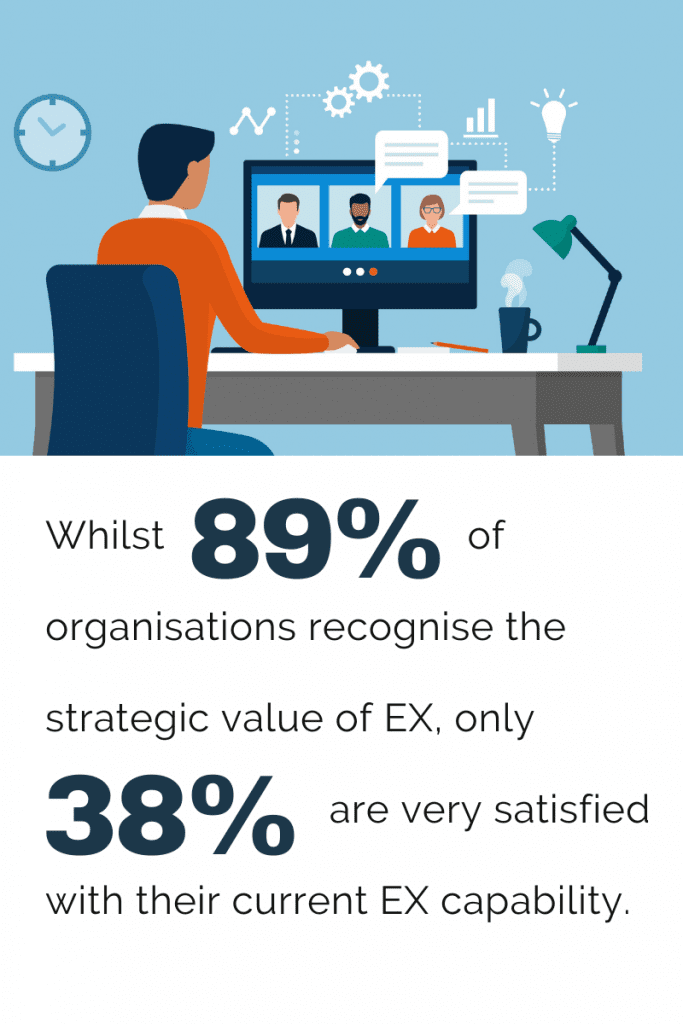Employee experience is a top priority in the post-COVID business climate.
By Marta Chmielowicz
The emergence of remote work has forced organisations to reimagine the workplace, accelerate digital transformation, and enhance the employee experience (EX).
According to NTT’s 2020 Intelligent Workplace Report, remote work will be leveraged in the future, with nearly 54% of organisations claiming that they will use a more distributed workforce model and 34% of C-suite executives saying they’re looking to reduce office space. Most organisations in APAC, the Middle East, and Africa anticipate it will take over a year to return to office life, whilst those in Europe and the Americas forecast a return within 12 months.
To remain relevant in this complex, challenging environment, organisations need an employee-centric workplace strategy that enables them to achieve their goals. However, there is still a long way to go; NTT’s research indicates that whilst 88.9% of organisations recognise the strategic value of EX, only 38.3% are very satisfied with their current EX capability.
The report offers some insights into how organisations can amplify their EX strategies for business success.
- Focus on well-being. Protecting the health and well-being of employees has emerged as the number one challenge to optimising the remote workforce as employees struggle with disconnection and burnout.
Most organisations still have significant room for improvement in this area. The research shows that 63.3% conduct employee surveys to gauge morale and motivation levels, yet only 40.9% track employee wellness and well-being.
 Offer choice and flexibility. A flexible work policy is one of the top five factors identified in optimising workplace EX. Rigid approaches to office-based work won’t go far in attracting and retaining talent in today’s business climate. Organisations must create a culture that values individual choice and empowers employees to make decisions whilst ensuring they have the tools to be successful in their roles.
Offer choice and flexibility. A flexible work policy is one of the top five factors identified in optimising workplace EX. Rigid approaches to office-based work won’t go far in attracting and retaining talent in today’s business climate. Organisations must create a culture that values individual choice and empowers employees to make decisions whilst ensuring they have the tools to be successful in their roles.
According to the research, 75% of organisations agree that employees would prefer to have the choice and flexibility to work in an office when it is safe to do so. Younger demographic groups are more likely to prefer office-based work (41.3%) than those aged 50 and above (29.5%). However, as of August 2020, just 51.7% of organisations globally had formalised their expanded work from home policy.
- Digitise for relevance, innovation, and growth. The vast majority (88.5%) of organisations have become more reliant on technology since the start of the pandemic, with reliance on technology highest in APAC (94.1%).
In particular, the top five technology focus areas are:
-
- Mobile and remote working tools and networks
- Analytics and Internet of Things (IoT)
- Collaboration tools
- Managing security/risk/endpoints
- Digital events
However, just 45% of organisations strongly agree that employees have the necessary technology to work remotely, and many are struggling with the challenges of cybersecurity in a remote climate. In fact, 76.9% of organisations are finding it more difficult to spot IT security or business risk brought about by employees when they are working remotely. As a result, 83.2% have reassessed their security to accommodate new ways of working brought about by the pandemic.
- Consider workplace design. As organisations transition back to office-based work, they will need to reconsider the purpose of the physical office. NTT’s research indicates that 43.8% of organisations are reviewing their workplace design and considering how best to utilise space to amplify the creative and collaborative aspects of work.
Several approaches are emerging:
-
- 45% will advance video conferencing and collaboration to enable flexibility.
- 9% will provide more planned meeting spaces.
- 4% will reduce individual desk space.
- 2% are implementing additional creative spaces.
Sustainability is also a key consideration, with 89.4% of HR leaders saying that having a sustainable workplace helps attract and retain talent and 86.5% saying that workplace design is a key pillar in the sustainability agenda.
Energy efficiency of workplaces is the most common sustainability focus area (42.7%), followed by educating employees about sustainability (37.6%) and using cloud computing (36.7%) and digital tools and events (34.3%) to reduce the organisation’s carbon footprint.
The pandemic has fundamentally changed workplace policies, technologies, and designs, but by harnessing this change, organisations can enhance their performance, their employee experience, and the health and happiness of their workforce.













